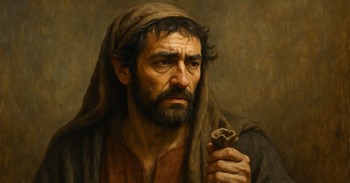Agnus Dei is a Latin phrase translated “Lamb of God.” It is part of a liturgical prayer in Catholic Mass, and it has inspired music and artwork throughout history. What is so special about the phrase? These two (or three) words are packed with a meaning and significance that spans the Old and New Testaments.
Agnus Dei Definition and Significance
Lambs have been a key part of the livelihood and worship of the Israelites since the Garden of Eden. Raised for their wool and as a food source, lambs were sacrificed to show gratitude to God for His holiness and providence. When Moses was called to free the Israelites from Egyptian slavery, the lamb became a symbol of the Passover. The Mosaic law featured lambs as the premier animal for sacrifice, including the annual sacrifice for the sins of the people for the year.
When the phrase "Lamb of God" was applied to Jesus, it held an even greater significance. Jesus’ sacrifice on the cross was the ultimate blood sacrifice that covered not just the sins of the people of his time, but the sins of all people for all time. It is not surprising that over time the church has found a way to incorporate the phrase into its liturgy.
According to Merriam-Webster, Agnus Dei in church worship consists of the three following lines:
Lamb of God, who takest away the sins of the world, have mercy upon us!
Lamb of God, who takest away the sins of the world, have mercy upon us!
Lamb of God, who takest away the sins of the world, grant us peace!
The first line may be repeated as many times as necessary during the breaking of bread in the Eucharist celebration. Then, the final is spoken.
Agnus Dei was first introduced as part of the Roman Rite Mass by Pope Sergius (687-701) as a rejection of the Council of Trullo in 692, which forbade Christ to be represented as a lamb instead of a man in any iconography. The phrasing is sometimes changed depending on the liturgical season and the denomination; however, the main concept remains the same with the focus on Christ as the Lamb of God.
Agnus Dei in the Bible: Key Verses & Themes
References to lamb of God and the Lamb of God are scattered across scripture. However, the main context for the phrase Agnus Dei comes from John 1:29:
“The next day John saw Jesus coming toward him, and said, "Behold! The Lamb of God who takes away the sin of the world!”
John repeats this again to his disciples in John 1:35-36. Other scriptures that refer to the Lamb of God include the following:
- 1 Corinthians 5:7 – Christ is called our Passover, referring to the Passover lamb.
- 1 Peter 1:18-19 – Christ as a spotless lamb.
- Revelation 5:5-8 – Christ as the slain lamb worshipped in Heaven.
Other references that point to Jesus as the sacrificial lamb include Isaiah 53:7, which prophesies of Christ being afflicted yet silent as he is led to the slaughter like a lamb. Colossians 2:14 states that Christ’s sacrifice on the cross took away the sin of the world.
Why Is Jesus Called the “Lamb of God”?
Jesus as the Lamb of God is also mentioned repeatedly in Hebrews as the author draws a comparison between the sacrificial lambs of the Old Testament and Christ as the ultimate blood sacrifice:
- Hebrews 9:16-22 – Compares the Mosaic sacrificial laws to Christ’s sacrifice on the cross.
- Hebrews 11:4 – Refers to Genesis 4:1-10 where Abel’s sacrifice was preferred because he gave with the right heart.
- Hebrews 11:17-19 – References Abraham’s willingness to offer Isaac as a sacrifice but a Ram wearing a crown of thorns was provided instead.
Paul also explains in 1 Corinthians 15 how Christ has fulfilled the old covenant which required constant sacrifices with a perfect sacrifice that was for once and all time.
From Genesis to Revelation, the Bible is filled with references to the Lamb of God. Abraham’s only son was rescued from being a sacrifice by God providing a ram wearing the crown of thorns. Then Jesus, God’s only son and a descendant of Abraham through the line of David, was crucified wearing a crown of thorns to become the ultimate sacrifice for the sins of all men throughout all time.
Agnus Dei in Prayer and Music
The liturgical prayer Agnus Dei has also inspired music from some of the world’s greatest composers. Beethoven, Schubert, Schumann, and Verdi added it to their mass and requiem compositions. Bach used it as the final movement in “Mass in B Minor” (1724).
Modern art depicts the Agnus Dei using the symbol of a lamb with a crown of thorns and carrying a banner with a cross. It is used in paintings, prints, and carvings. There are countless variations depicting the concept in just about every medium known in the art world.
Conclusion: Why This Phrase Matters for Everyday Christians
Christ is Agnus Dei, the Lamb of God. Christians need to understand that God had a plan to save the world from the beginning. The references are scattered throughout the Old and New Testaments of the Messiah who would save us not by earthly dominance but by eternal reconciliation with God:
- In Genesis, the ram with the crown of thorns, provided as the sacrifice instead of Isaac, is a typology or foreshadowing of the ultimate sacrifice of Christ.
- In the Gospels, Jesus was the Passover Lamb who was crucified on the cross at the same time the annual sacrifice was offered in the temple.
- In Revelations, Jesus is the Lamb of God who sits victorious on the throne of Heaven. He has overcome sin and death and taken away the sin of the world and will return to claim his own.
As Christians, we now live in that victory over sin. Even though we still live in a physical body prone to sin, we now have a mediator who reconciles us to God. We don’t have to offer blood sacrifices through a priest because Jesus is our Agnus Dei, once and for all.
The old covenant of blood sacrifices has been replaced by the blood of the Lamb of God who takes away the sin of the world. We have a high priest whose perfect sacrifice gives us access to the throne of Heaven at all times. We are truly blessed because now we can have a personal relationship with God. We no longer have to depend on an earthly priest.
But we aren’t meant to keep this knowledge to ourselves. We have been commissioned to go out into the world and share with others the Good News so that they, too, can receive forgiveness, mercy, and peace.
John the Baptist proclaimed, "Behold! The Lamb of God who takes away the sin of the world!” (John 1:29). John was sent to prepare the way for Christ’s coming and to point others toward Christ. As Christians, we are meant to continue pointing others to Christ, the Lamb of God that takes away the sin of the world. May he have mercy on us and grant us peace.
Photo credit: ©GettyImages/KristiLinton
Linda Lyle is a writer, teacher, knitter, and unintentional collector of cats. She has written articles for the Alabama Baptist, Open Windows, Refresh, as well as multiple novels and novellas. Her newest book, 5-Minute Prayer Plan for When Life Is Overwhelming, is set to release in October. She spins yarns on her blog The End of My Yarn at lindalyle.com.




